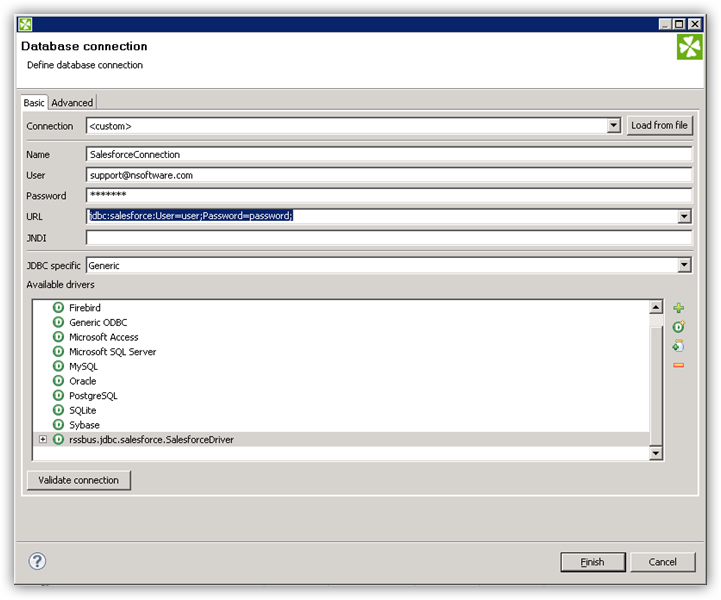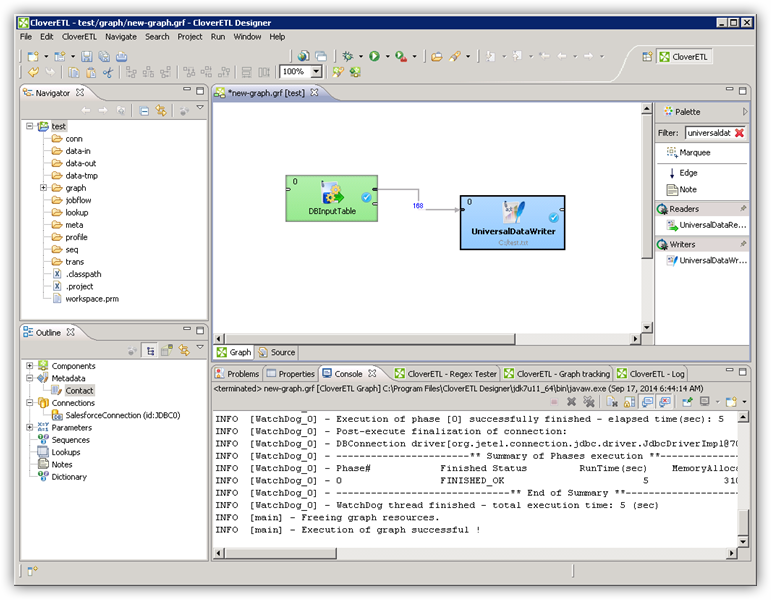Discover how a bimodal integration strategy can address the major data management challenges facing your organization today.
Get the Report →Connect to SAS xpt Data in CloverDX (formerly CloverETL)
Transfer SAS xpt data using the visual workflow in the CloverDX data integration tool.
The CData JDBC Driver for SAS xpt enables you to use the data transformation components in CloverDX (formerly CloverETL) to work with SAS xpt as sources. In this article, you will use the JDBC Driver for SAS xpt to set up a simple transfer into a flat file. The CData JDBC Driver for SAS xpt enables you to use the data transformation components in CloverDX (formerly CloverETL) to work with SAS xpt as sources. In this article, you will use the JDBC Driver for SAS xpt to set up a simple transfer into a flat file.
Connect to SAS xpt as a JDBC Data Source
- Create the connection to SAS xpt data. In a new CloverDX graph, right-click the Connections node in the Outline pane and click Connections -> Create Connection. The Database Connection wizard is displayed.
- Click the plus icon to load a driver from a JAR. Browse to the lib subfolder of the installation directory and select the cdata.jdbc.sasxpt.jar file.
- Enter the JDBC URL.
Connecting to Local SASXpt Files
You can connect to local SASXpt file by setting the URI to a folder containing SASXpt files.
Connecting to S3 data source
You can connect to Amazon S3 source to read SASXpt files. Set the following properties to connect:
- URI: Set this to the folder within your bucket that you would like to connect to.
- AWSAccessKey: Set this to your AWS account access key.
- AWSSecretKey: Set this to your AWS account secret key.
- TemporaryLocalFolder: Set this to the path, or URI, to the folder that is used to temporarily download SASXpt file(s).
Connecting to Azure Data Lake Storage Gen2
You can connect to ADLS Gen2 to read SASXpt files. Set the following properties to connect:
- URI: Set this to the name of the file system and the name of the folder which contacts your SASXpt files.
- AzureAccount: Set this to the name of the Azure Data Lake storage account.
- AzureAccessKey: Set this to our Azure DataLakeStore Gen 2 storage account access key.
- TemporaryLocalFolder: Set this to the path, or URI, to the folder that is used to temporarily download SASXpt file(s).
Built-in Connection String Designer
For assistance in constructing the JDBC URL, use the connection string designer built into the SAS xpt JDBC Driver. Either double-click the JAR file or execute the jar file from the command-line.
java -jar cdata.jdbc.sasxpt.jarFill in the connection properties and copy the connection string to the clipboard.
![Using the built-in connection string designer to generate a JDBC URL (Salesforce is shown.)]()
A typical JDBC URL is below:
jdbc:sasxpt:URI=C:/folder;

Query SAS xpt Data with the DBInputTable Component
- Drag a DBInputTable from the Readers selection of the Palette onto the job flow and double-click it to open the configuration editor.
- In the DB connection property, select the SAS xpt JDBC data source from the drop-down menu.
- Enter the SQL query. For example:
SELECT Id, Column1 FROM SampleTable_1 WHERE Column2 = '100'
Write the Output of the Query to a UniversalDataWriter
- Drag a UniversalDataWriter from the Writers selection onto the jobflow.
- Double-click the UniversalDataWriter to open the configuration editor and add a file URL.
- Right-click the DBInputTable and then click Extract Metadata.
- Connect the output port of the DBInputTable to the UniversalDataWriter.
- In the resulting Select Metadata menu for the UniversalDataWriter, choose the SampleTable_1 table. (You can also open this menu by right-clicking the input port for the UniversalDataWriter.)
- Click Run to write to the file.








